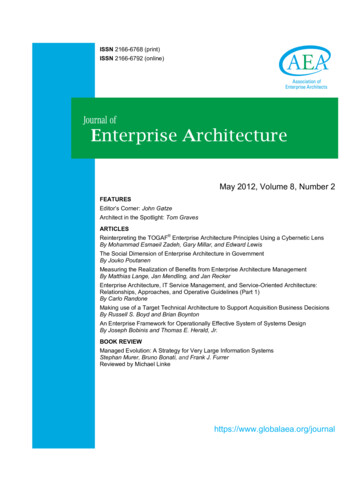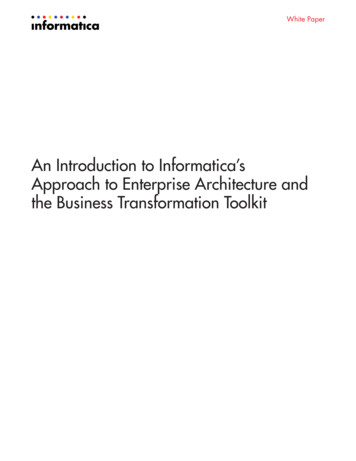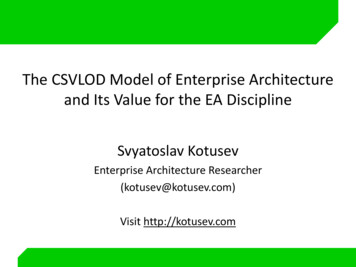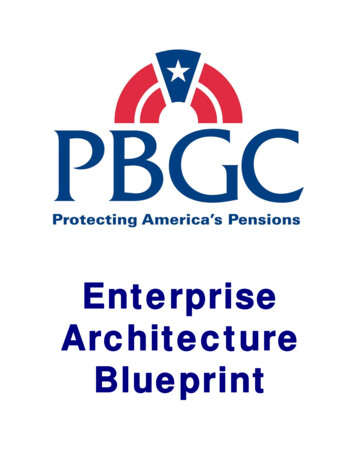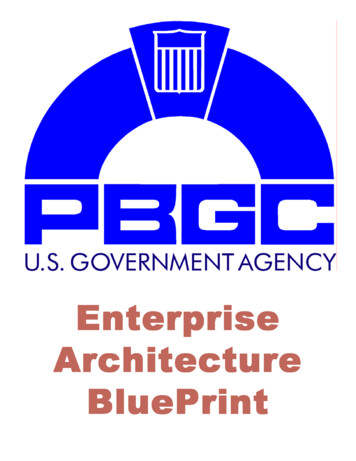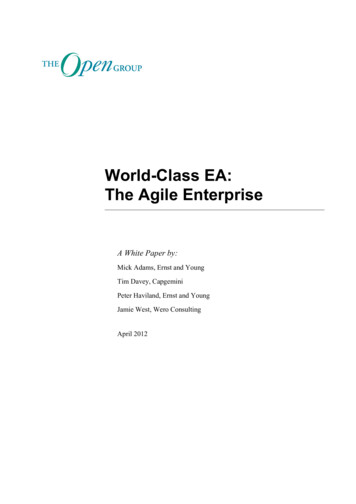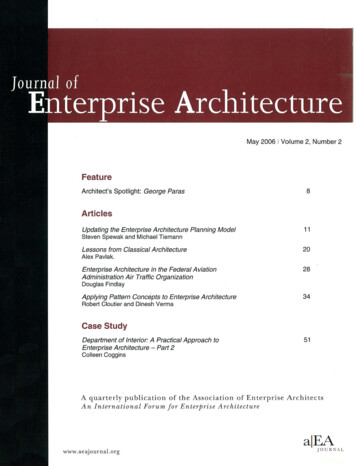
Transcription
IJournal of!Enterprise ArchitectureMay 2006 I Volume 2 , Number 2FeatureArchitect's Spotlight: George Paras8ArticlesUpdating the Enterprise Architecture Planning Model11Steven Spewak and Michael TiemannLessons from Classical Architecture20Alex Pavlak.Enterprise Architecture in the Federal AviationAdministration Air Traffic Organization28Douglas FindlayApplying Pattern Concepts to Enterprise Architecture34Robert Cloutier and Dinesh VermaCase StudyDepartment of Interior: A Practical Approach toEnterprise Architecture - Part 251Colleen CogginsA q ua rt e rl y p u b li catio n of t h e Assoc iatio n of Enterprise Arc hi tectsAn I nternational Forum for Enterprise Architec turea\EAwww.aeajo urnal .o rgJO U R NA L
Journal of Enterprise ArchitectureEditor:Scott Bernard, PhDCarnegie Mellon University / Syracuse UniversityAssociate EditorsBeryl Bellman, PhDCalifornia State University,Los AngelesAndrew Blumenthal, MBAChief Enterprise ArchitectU.S. Secret ServiceJohn Gotze, PhDDepartment of InformaticsCopenhagen Business SchoolPatrick Bolton, MSMichelle Kaarst-Brown, PhDWilliam Krauter, PhD. EA Practice LeadBAE Systems, Inc.School of Information StudiesSyracuse UniversityLockheed MartinCorporationHaiping Luo, PhDStephen Marley, PhDThomas Mowbray, PhDSenior Enterprise ArchitectDepartment of Veterans AffairsSenior Enterprise ArchitectNASASenior Enterprise ArchitectKeane, Inc.Kristian Hjort-Madsen, MSMatthew Newman, MSFelix Rausch, MSDanish Ministry ofProfessor, IRM CollegeNational Defense UniversityFederal EA Certification InstituteAnn Reedy, PhDKathie Sowell, MMMichael Tiemann, MSSMSenior Enterprise ArchitectMitre CorporationSenior Enterprise ArchitectMitre CorporationScience, Innovation and TechnologyExecutive DirectorSenior Enterprise ArchitectBooz I Allen I HamiltonAbout the Journal: The Journal of Enterprise Architecture (JEA) is a peer-reviewed international quarterly publication of the Associationof Enterprise Architects (aIEA). Issues are published in February, April, August, and Novernber each year. JEA supports global academicand practitioner communities of interest through the publication of articles that promote the profession of enterprise architecture, issuesregarding practices and methods, case studies, and standards at the national and international level.Copyright: all rights reserved. The reproduction, storage, or transmission of JEA articles or other content is prohibited without priorpermission in writing from the JEA Editor, who can be contacted via email at scott.bernard@aeajournal.org or in writing at 6348 CrookedOak Lane, Falls Church, Virginia, 22042.Article Submissions: Authors may submit properly formatted manuscripts to the JEA Editor at scott.bernard@aeajournal.org forpeer-review and publication consideration. Author subrnission guidelines are available on the alEA website at www.aeajournal.org.Approximate timeframes frorn submission to publication for successful manuscripts are 6 to 12 months, depending on the backlog ofpreviously accepted manuscripts. Copyright of all accepted articles and other published content is transferred by the author to JEA uponnotification of acceptance by the JEA Editor.Subscriptions: One-year subscriptions to JEA can be ordered for 75.00 (USD) per year through the alEAwebsite at www.aeajournal.org and can be paid for on-line (Visa, MasterCard, or American Express), or by downloading and mailing the JEA Subscription/alEAMembership Form and a check to the Chief Editor at 6348 Crooked Oak Lane, Falls Church, Virginia, 22042. Student subscriptions areavailable at 45.00 for college students and for the first year for those in alEA-affiliated EA training classes. A group rate is availablefor 300.00 for 5 individuals from the same organization (each person will receive a copy of JEA). All subscriptions to JEA includemembership in the Association of Enterprise Architects (aIEA).Back Issues: Copies of a JEA back issue can be ordered through the alEA website for 5.00 plus 2.00 U.S. domestic shipping or 3.50 international shipping (per copy). Expect 1-3 weeks to receive each order. The shipping price for orders of multiple copies of JEAback issues must be coordinated via email with the JEA Editor at scott.bernard@aeajournal.org.aJEA Membership: Membership in alEA is automatically obtained and maintained through subscription to JEA. Each subscriber isassigned to the alEA Chapter that is nearest to that member, or to the global "At-Large Chapter." Selection of alEA Chapter affiliation ismade by the subscriber/member as part of the initial subscription and annual renewal process, done online at www.aeajournal.org, or viathe downloadable form (see Subscriptions).
- -- - ----- - --- - - - - - --------The Journal of Enterprise ArchitectureMay 2006Volume 2, Number 2FeaturesEditor's Corner2alEA International Committee News and Events3alEA Local Chapter Points of Contact4Architect's Toolbox5Architect's Spotlight: George Paras8ArticlesUpdating the Enterprise Architecture Planning Model11Steven Spewak and Michael TiemannLessons from Classical Architecture20Alex PavlakEnterprise Architecture in the Federal A viation AdministrationAir Traffic Organization28Douglas FindlayApplying Pattern Concepts to Enterprise Architecture34Robert Cloutier and Dinesh VermaCase StudyDepartment of the Interior: A Practical Approach toEnterprise Architecture - Part 251Colleen Coggins Journal of Enterprise Architecture - May 20061
alEAJOURNALScott Bernard, EditorThe May 2006 issue of JEA is our fourth issueand marks the completion of the first full "set"of this quarterly publication. I continue to beimpressed with the quality and variety ofsubmissions we are getting from authorsaround the world, and I thank each of theauthors who have contributed thus far. TheAugust 2006 issue will be somewhat unique inthat it will be devoted to EA standards. We willresume the regular format of articles and casestudies on a variety of EA subjects in theNovember 2006 issue.JEA will continually be in the hunt for highquality articles on EA that have not beenpreviously published. We are fortunate to nowhave a modest backlog of manuscripts thathas put the "submission-to-print" delay at 6-9months, so authors submitting manuscripts thisspring and summer (that are accepted by ourBoard of Editors) will see the resulting article inthe February or May 2007 issue. The line willonly get longer, so get your articles in soon.Manuscripts are submitted to the Editor atscott.bernard@aeajournal.organdthesubmission format and guidelines are availableon alEA's website at www.aeajournal.org.Please note that back issues of JEA areavailable for 5.00 plus shipping, order themby contacting the Editor via email (see detailson the inside cover). Also, the Board ofEditors decided in December to begin allowingadvertising in JEA on a limited basis. I havepushed back the start of an advertisementsection to the August 2006 issue due tovarious production, notification, and timingissues. As was mentioned in the last issue,this will be done tastefully in a way that anddoes not give a commercial feel to JEA. Thereasons for allowing advertising are twofold:(1) advertising income will supplementmember dues and help to keep the price ofJEA as low as possible; and (2) to allow thevendors that support the EA community to bemore visible in a way that maintains JEA'sneutrality on products and approaches. Wewill also provide page for members and otherindependent EA consultants to post a smalladvertisement at a nominal fee. Journal of Enterprise Architecture - May 20062We begin the May issue of JEA with "Architectin the Spotlight" that features George Paras,Vice President of Strategy for TrouxTechnologies, a long time mover and shaker inthe EA community, and the Editor andGovernance.com). I metwith George in March, at the EAC (EAConference) in Orlando, Florida. EAC is heldtwice a year and is the longest running andperhaps largest ongoing EA event anywhere.The "Architect's Toolbox" feature is an analysisof Ala Win by our tool expert, David Rice.The "Articles" section begins with a wonderfuland unique contribution by Steven Spewakand Michael Tiemann on "Updating the EAPModel."Mike and Steve had beencollaborating on the EAP update when Stevepassed away in 2004, and we a fortunate thatMike was able to finish the work and obtainpermission from Steve's other businesscolleagues to allow the publication of thisarticle, which not only makes the EAPapproach more relevant and current, butrepresents yet another contribution to the EAcommunity by one of the founders.The next article is a very insightful piece byAlex Pavlak on the lessons that the EAcommunity canlearn fromtraditionalarchitecture. This is Alex's second article inJEA, and his cogent writing style and insightfulanalysis drew some of the highest marks todate from our Board of Editors. The thirdarticle by Douglas Findlay provides aninteresting look at how EA is beingimplemented in one of the Federal AviationAdministration's key business units. The lastarticle by Robert Cloutier and Dinesh Verma isa highly original look at how patterns and therecognition thereof are a foundational aspectof EA. The featured Case Study is the secondof a two-part article on how the Department ofthe Interior turned around a troubled EAprogram to become one of the leadingarchitectures in government.I hope you enjoy this issue of JEA and I thankyou for your support and readership.
alEAJOURNALInternational Executive Committee President: Scott Bernardscott.bernard@aeajournal.org Vice President: Jaap Schekkermanjaap.schekkerman@aeajoumal.org Secretary: Kristian Hjort-Madsenkristian.hjort-madsen@aeajournal.org Treasurer: Mike Hall Resources Coordinator: Tanaia rnal.orgSince December, the International Committeehas been busy working on the update of thealEA website and the establishment of a newlinked blogging site. John Gotze (one of JEA'sAssociate Editors), Mike Hall, and TanaiaParker have been collaborating on theseimprovements, which will continue thru June.As always, we welcome input and content fromalEA members. There is now a link to an EAdocument library on the alEA websitehomepage (www.aeajournal.orgl; found at the"Library" tab, accessible only to members.Another addition to alEA services is a quarterlyelectronic newsletter to be sent via email.Just as we did last quarter, alEA welcomes twonew chapters; the New Zealand Chapter andthe New York City Chapter. This makesseventeen chapters plus the "Global-at-LargeChapter." Also, alEA now has just over 400members, with 18% growth seen in the lastquarter alone.Please remember thatrenewing your annual membership is done viathe alEA website at www.aeajournal.org. MikeHall (the alEA Treasurer and Webmaster) hasadded functionality that now allows membersto update their profiles at any time, includingchapter affiliation. This helps members whojoined before there was an alEA Chapter intheir area.As a reminder, back issues are available for 5.00 USD plus shipping. Orders are nal.org.International Standards Committee Chair: Haiping Luohaiping@aeajournal,orgThe alEA International Committee on EAStandards serves two related purposes: (1)identify, develop, and promote internationalstandards on enterprise architecture; and (2)build,manage, and expand anEAknowledgebase in aIEA. The Committee iscontinuingtodevelop theEnterpriseArchitecture Management Guide that providesa taxonomy of EA topics and candidate EAstandards. The Committee has established twosubcommittees on EA tool interoperability sEAcommunity'sinvolvement and contribution. Please contactDr. Haiping Luo at haiping@aeajournal.org ifyou would like to help with EA standards work.2006 alEA International ConferenceOctober 2006 - Seoul, KoreaalEA will hold its first annual InternationalConference in late October in Seoul, Korea.The conference will feature presentations bylocal and global alEA members, industrypractitioners, and government officials on EAissues of interest to the internationalcommunity; including standards, taxonomies,tools, and methodologies.Registrationinformation will be provided in the quarterlyemail newsletter and the August issue of JEA.2006 alEA U.S. ConferenceSeptember 2006 - Washington, DCalEA will hold its second annual U.S.Conference meetings in September 2006 aspart of a larger government and industry EAConference at the Ronald Reagan FederalBuilding in Washington DC. Details will followin the quarterly email newsletter and theAugust issue of JEA. Journal of Enterprise Architecture - May 20063
alEAJOURNALInternationalUnited StatesAustralia ChapterDelaware Valley ChapterKeith Framptone4591 O@ems.rmit.edu.auMichael Robisonmichael.w.robison@lmco.comCanada ChapterDallas I Fort Worth, Texas ChapterMike Giovinazzomike@giovinazzo.caWilliam Krauterwilliam.krauter@lmco.comChile ChapterMid-South California ChapterAlfredo Piquer:apiquer@optimisa.clKenneth Griesikenneth.griesi@lmco.comDenmark ChapterMidwest ChapterJohn GotzejOhngotze@slashdemocracy.orgChuck OhmsChuck.Ohms.ctr@ustranscom.milGlobal At-Large ChapterNew York City ChapterScoll BernardscolI.bernard@aeajournal.orgBrian ClarkBClark@nyse.comKorea ChapterSeattle, Washington ChapterHong SikKimhskimyang@empal.comSteve Farowichsteve.farowich@boeing.comNew Zealand ChapterSyracuse, New York ChapterMike Lowemike.lowe@woosh.co.nzMike Hallmike.hall@aeajournal.orgSouth Africa ChapterTennessee Valley ChapterGraham McLeodmcleod@iafrica.comJon McKinleymCkinleyj@bah.comUnited Kingdom ChapterWashington DC Metro ChapterJohn Gooduk.aeajournal@googlemail.comMargaret Jamesmargaretjames@gmail.comReaders wishing to join the Association of Enterprise Architects (aIEA) and to subscribe to JEA canonly do so through the alEA website at www.aeajournal.org. Annual dues (including JEA subscription)are 75.00 USD for regular members, 45.00 for students, and a group rate of 300.00 for fivemembers. On-line payment with credit card is available (Visa, MasterCard, American Express), and adownloadable mail-in form is also available for those who prefer to send a check.alEA members can select the local chapter that they want to belong to, if one exists nearby. Allmembers who are not part of a local chapter are automatically assigned to the Global At-LargeChapter. Members can change their chapter affiliation when they renew their membership, or bysending an email to the alEA treasurer and webmaster, Mike Hall, at mike.hall@aeajournal.org. ThealEA Local Chapter points of contact are listed above. Please contact these people for information onLocal Chapter events, meetings, and locations. Journal of Enterprise Architecture - May 20064
alEAJOURNALDavid RiceReview of KBSI's AI" Win 7.0When people refer to Enterprise Architecture(EA) modeling tools they are typically referringto expensive, behemoth tools that attempt to"do it all" and "be everything to everyone."Considering the volume of data to be collectedin many EA projects, and the myriad of formsin which it is to be collected, a variety of EAmodeling and analysis tools are often needed.Just. as a mechanic's toolbox should have aspanner for a variety of tasks, the toolboxshould also have specific precision tools if thearchitect is expected to be able to do qualitywork across the spectrum of EA activities.Sometimes, combining tool functionality iscalled for and the productivity gains of aprecision tool often justify the investment inthat tool and an interface to a larger EA tool.Tool Overview and PurposeA/0 Win is an IDEF-O activity modeling tool,and one might call it a precision tool forspecific types of EA work. A/0 Win is veryrelevant for those following the Department ofDefense Architecture Framework (DODAF) orfor use in many industries that need detailedactivity models and where there is a desire towork with an activity modeling language thathas a proven track record and is stable.Doubtless the preceding statement will stir uppreferences over methodology among manyarchitects, and those favoring Object-Oriented(00) approaches to activity modeling that usethe Unified Modeling Language (i.e., UseCases, Event-Trace Diagrams, and ActivitySequence Diagrams) will also have their day ina future issue's Architect's Toolbox.It suffices to say that in the DoD EA spaceIDEF-O activity models are the preferred formfor completing the OV-5 artifact. That beingsaid, it is also true that the built-inimplementations of IDEF-O in several of thelarger EA tools (e.g., System Architec(TM, andMetisTM) can be difficult to use and even someof the smaller more focused tools such asProforma have built-in IDEF-O features thatare equally difficult to use. In several tools theimplementation IDEF-O is nowhere near thestandard specifications from IEEE and FIPSfor symbology and use.A/0 Win is a very specialized tool thatimplements IDEF-O well. It does so in a dataand rules oriented manner, so that thearchitect can focus on the job at hand (datacollection and analysis) and not on thenuances of diagram drawing and rememberingall the method rules and constructs - the A/0Win tool effectively takes care of that.Just to make this perfectly clear, given a set ofactivities, related in a hierarchy the toolproduces the necessary IDEF-O diagrams andnode trees; given a set of Inputs. Controls,Outputs, and Mechanisms (ICOMs) the toolwill produce a fully "drawn" IDEF-O diagramthat is properly balanced and validated.The architect can use the traditional views of aNode Tree and Activity Diagram to input IDEFo information, and A/0 Win makes this easy byauto-placing and auto-drawing the input (andauto-redrawing and balancing if a change inorder or hierarchy is made). A/0 Win alsoprovides a unique input mechanism called an"Activity - ICOM Matrix." In this matrix thearchitect assigns 'Concepts' (what A/0 Wincalls a "yet unassigned ICOM") to an 'Activity'via a matrix by clicking in a cell with theappropriate modeling letter selected: I, C, 0, orM. This attaches the 'Concept' to the 'Activity.'The rules engine knows what is attached towhat in real time and prevents the architectfrom assigning ICOMs in a structure that wouldviolate IDEF-O rules. You can change levels ofthe model within the matrix as well, and whenyou do change levels you find that y and the ICOMS are ready for useat the new level.Auto-balancing, ruleenforcement, and automatic drawing andplacement are the "magic" the make the use ofWin A/0 for creating and editing an IDEF-Omodel so fast and easy. Journal of Enterprise Architecture - May 20065
Installation on Your PCTalk about easy, A/0 Win is essentially adesktop PC-based activity modeling andanalysis tool, and the installation is actuallyeasier than many commercial desktopapplications I have worked with. Installing A/0Win takes only a minute or two and is up andrunning - no glitches noted in my experience.SetupWhen you start up the A/0 Win software itasks to you configure a "repository". A/0 Winis a tool-based modeling tool and repositorythat is essentially a file on your hard drive, butsomething that is significant to note is thatwhat you are actually setting up is a sharedspace for IDEF-O models. You can havemultiple models in one file and they can sharecommon Activities and Concepts, ICOMs, andSources across these models.Overall ArchitectureIn the modeling tool space there are twoclasses of tool. Tools that aid in your thinkingand analysis process and tools that presumeyou have done that and need to document theresults. Most modeling tools fall in the lattercategory. The structure and purpose of A/0Win seems to be for the former.A/0 Win's architecture is that of a rules engineat the core - knowledgeable of the rules ofIDEF-O, both of the allowable relationships ofactivities and ICOMs and also of the numbersof boxes per page and how they and theirICOMs should be laid out. The tool allows fora small amount of flexibility here for buildingpurposes, but flags the diagram as FEO (ForExposition Only) which is the standard IDEF-Onotion for a diagram that does not meetstandards.On top of this rule base are four basicinterfaces for building the IDEF-O model; aNode List, a Node Tree, an Activity Diagram,and an Activity-ICOM Matrix. These interfacesare interlinked via the data inherent to themodel. A change to the model in anyoneinterface is immediately reflected in the othersbecause essentially they are all co-related inchanging the data. About the most fascinatingthing you can show to someone that is used to"drawing" an IDEF-O diagram is to build the"Activity Diagonal" in the Activity Model, switch Journal of Enterprise Architecture - May 20066to the Matrix, and fill in the ICOM informationand then change screen windows to theDiagram view and then see the completediagram drawn. Most do not believe it at first,and then remark about how much time theywasted in doing IDEF-O with other tools.Version ControlThere really is none in A/0 Win.based tool so backup your files.It is a file-CustomizabilityThere is a facility to add some user-definedattributes to the Activities, ICOMs, etc., but asfar as the types of customizations we have intools like Metis and System Architect, this toolis nowhere close.Integration CapabilityIDEF-O has a standard interchange languagecalled IDL (not to be confused with CORBAIDL). A/0 Win supports this language to adegree but since it auto-places and routesdiagrams, it does not store its coordinates souser attempts to use IDL to transport models toother IDEF-O tools resulted in data but not thediagrams being transported.Other interface mechanisms exist, however,such as SVG for diagram rendering, and XMLVisio Interface for import and export (aproprietary but easily readable text file format).Available IntegrationsThere is a commercial bi-directional integrationwith System Architect.Analysis CapabilityA/0 Win has extensive Activity Based Costingcapability as well as integration with KBSI'sother costing tools: EasyABC Plus orEasyABC Ouick .Reporting CapabilityBuilt-in reports are not customizable, but areselectable in content,. There is no reportinglanguage such as SOL.I strongly favorbuilding the model in this tool and transportingthe data elsewhere for analysis. That beingsaid; the reports for IDEF-O that exist are good
and should be used if they fit the need. Theyare neat, clean, and well suited to the purposeof reporting the data in the standard form.Afro Win is just plain pleasant to use for IDEF-eighties. Certain common Windows notionsare not present, for instance there is no COMinterface, a feature found in most Windowstools these days. But what they do well theydo extremely well and better than the "MultiTool" type tools on the market - and that is agood thing for those of us who need it.and editing. I find it so fastand easy that I would have no reservationabout taking it into a facilitated architecturesession or one-an-one meeting and doing datagathering right in the tool. how many toolscan you say that about? Editing an existingIDEF-O model that was created in another tool,(particularly one where editing models,changing activity levels, and rebalancingICOMs is especially hard), is also relativelyeasy in Afro Win. It is worth investing in aninterface between Afro Win and larger EA toolsto do this type of model importing andmanipulation.Knowledge Based Systems, Inc.KBSI is a privately held company. It has beenin business since the mid-eighties and islargely an R&D shop, but also has hadcommercially available tools for most of itsexistence. Afro Win is one of its most maturetools and the company founder and President(Dr. Richard Mayer) was part of the ICAMproject in which the IDEF methods weredeveloped. KBSI looks to me to be a stablecompany with a successful track record. KBSIcan be reached at:Overall Impressionso model creationThe reporting and analysis functions of AfroWin leave something to be desired, and I favormoving IDEF-O model data out of the tool oncethe model is created for those purposes.There are simply stronger reporting tools andstronger analysis tools. The tool has thereports sufficient for strict IDEF-O reports and afew other useful reports but very little in theway of model analysis.One comment on version and adoption ofmodern technology; KBSI has been somewhatslow to upgrade Afro Win. It is only in version7.0 yet the tool was first released in the lateKnowledge Based Systems, Inc.1408 University DriveEast College Station, TX 77840Phone: 979.260.5274 Fax: 979.260.1965www.kbsLcomTool Cost:The per-license cost of the Afro Win tool iscurrently 2,000.00. Annual maintenance is 400.00.Contact David at davidr@eaframeworks.com Journal of Enterprise Architecture - May 20067
alEAJOURNALGeorge Paras: Vice President of Strategy, Troux TechnologiesThis issue's "Architect in the Spotlight" isGeorge Paras, Vice President of Strategy forTechnologies ,whoacquiredTrouxComputas and their popular Metis EA tool inearly 2005, and is also Editor-in-Chief ofArchitecture and Governance Magazine. Mr.Paras has more than 25 years of expertise inEA management processes, tions strategies. He has coachedand mentored hundreds of private and publicsector IT leaders through the launch anditerative refinement of their EA programs. Mr.Paras has helped establish current thinking onEA discipline best practices and methodsthrough his thought leadership, research,analysis, and evangelism of EA concepts asChairman and featured speaker for theEnterprise Architecture Conference. Prior tojoining Troux in 2005, Mr. Paras was VicePresident of the Enterprise Planning andArchitecture Strategies group at METAGroupTM.JEA: Mr. Paras, thank you for agreeing to beinterviewed as the featured architect for thisissue of JEA. Your work in the IT industry,with META Group, and now with TrouxTechnologies gives you a uniquely informedview of changes in the landscape of EApractice. In that light, what do see as beingthe most important issue that EA faces todayas a growing area of professional practice?G. Paras: The continued evolution of EA isentirely dependent on its acceptance as alegitimate management discipline. This is nosmall task. Too often viewed as a subspecialty within IT, I often see "architecture"receive too much emphasis while the"enterprise" aspect receives too little. To fulfillthe promise of EA, the discipline must operateto transform the enterprise from its currentstate to its strategic future, approaching theproblem from the context of the enterprise assystem. It must do so by considering allperspectives on EA, from business strategyand capabilities through services, processes,Overcominginformation and technology. Journal of Enterprise Architecture - May 20068misperceptions about the role of EA bydelivering fully across its potential is theessential element to the success of thediscipline.JEA: What do you see as being the mostpressing issue(s) for enterprise architects whowould like to make EA a career?G. Paras: While enterprise architects mustpossess a broad range of hard and soft skills,one skill stands out in my mind as critical tolong-term success.The ability to think,c?n?eptuallze and nalyze systemicallydistingUishes an enterprise architect from otherarchitects. Possessing, or developing, this skillgives the enterprise architect the ability totraverse all the abstraction levels of theenterprise. Doing so provides clarity on whereand when to target value activities, sustainingboth an EA practice and an individual career.JEA:You have been coordinating and/orhosting major EA conferences for over adecade. perhaps longer than any other EAthought leader. What are some of the insightsthat you've gained into the profession of EAthrough these gatherings, and what directiondo you think EA is going in?G. Paras: The EA profession continues toattract a steady stream of fresh talent, from allindustries, that is a real pleasure to see. Manyof these "newbies" come to EA after successfulcareers in other IT and managementdisciplines, contributing their own perspectives.Likewise, established professionals are onlygetting better. I see the same architects yearafter year at EAC. It is very clear that eachyear they move to a new, higher level. Manyhave become speakers and they share theirknowledge freely.To your second question, I think that EA isgoing in two directions. First, practitioners aregetting very good at the mechanics ofdelivering EA models, creating repositoriessupporting development teams, and runningan EA program to produce value. Second, Ithink a smaller subset of practicing enterprise
architects are taking it to the next level andcombining EA with IT Governance. Thesegroups are moving closer to the business'sstrategy function, the place I think EA willeventually reside.JEA: Service-Oriented Architecture (SOA) hasgained a good deal of attention in the pastthree years. How do you see SOA relating toEA?G. Paras: I think the vast majority of themarket, the analyst firms, the consultants, etc.have SOA mostly wrong. They focus too muchattention on the promises of the technology ofSOA, to deliver reuse and provide softwaredevelopment efficiencies. Don't misunderstandme, SOA shows promise as a way to helpsolve many problems, but I think what's mostimportant about SOA isn't the technology, butis instead the way· it drives us to look atourselves and the business. The philosophy ofa services approach forces us to think aboutfundamental building blocks, such as businessservices, and how they relate together in thecontext of a larger system, the enterprise.Think about this portfolio of services, thecharacteristics they must have, the rules tocombine and recombine them for agility, andidentify how they deliver value to theenterprise, from my perspective that's
The Journal of Enterprise Architecture May 2006 Volume 2, Number 2 Features Editor's Corner alEA International Committee News and Events alEA Local Chapter Points of Contact Architect's Toolbox Architect's Spotlight: George Paras Articles Updating the Enterprise Architecture Planning Model




